It's a battlefield bonanza!
Well, it's been a few days since I last made a proper update. That's not to say that there hasn't been anything to talk about - a combination of illness, lack of internet, good movies on TV and a slight case of intoxication has combined to keep me from doing the full monty in terms of updating the blog. However, we've stopped somewhat earlier today, and as such, I'm catching up. Where was I? Oh yes. After leaving Manassas and the Air Museum, we spent the next day driving through four battlefields, as mentioned in the previous blog. The first battlefield we saw, Fredericksburg, is the most affected by development out of the four. The original battlefield was fought when the town was a lot smaller, and long, gently sloping ridge existed, stretching from the town up the hills to the Confederate position, where their troops were dug in behind a stone wall. The Union commander, a chap called Burnside, foolishly ordered a frontal assault against this near impenetrable position, resulting in unmitigated slaughter of the Federals, given the strength of the Confederate defences.
Nowadays, houses reach right up to within twenty metres of the wall, with only the wall itself and a small park along the summit of the ridge behind it intact. Whilst it does make it somewhat difficult to visualise how the battle panned out, you can still see some impressive sights.
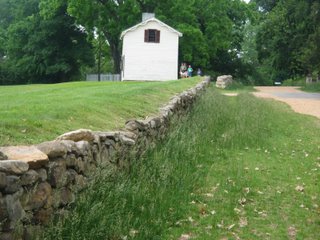
An original section of the stone wall. The Confederates, safely kneeling behind the wall, were able to punish the Federals with relative impunity. Given the ability of a rifle musket to reach out and touch someone at over 300 metres with accuracy, and that the Federals had close to a kilometre of open ground to cross, it's easy to see why the attack was such a catastrophe. In front of the stone wall at Fredericksburg, close to 8000 Federals were casualties, as opposed to scarcely 1000 Rebels.

This graveyard was on the crest of the ridge, and was already present when the battle began. As you can see, it was not spared by Federal cannonballs, which were aimed at Confederate artillery positioned further along the ridge.

The interior wall of a house near the Confederate firing line. The amount of bullet holes to be seen testifies to the ferocity of the fighting that occurred here.

I found this next to the road running behind the wall. Laziest cat ever.
Anyways, after Fredericksburg, we moved on to Chancellorsville, scene of Robert E Lee's greatest ever victory over the Federals. It came at a high price though, losing his best subordinate, the brilliant and ultimately irreplaceable Stonewall Jackson.
Chancellorsville is in a much better condition than Fredericksburg, due to it's distance from urban areas. The battle fought here was a masterpiece of manoeuvre, as Lee and Jackson skillfully redeployed their 60000 troops in such a fashion as to convincingly rout 110000 Federals under Joseph Hooker. Although they were aided in the confusion generated by the thick forests in the area, meaning Hooker was unable to coordinate and bring to bear his full weight of numbers, the same conditions contributed to the circumstances in which Jackson was killed.
The first day of the battle began in late afternoon when Jackson, who had managed to secretly bring 35000 of his troops around to the Union flank, sent his troops forward in a screaming assault on the unsuspecting Union troops in front of him, sending them flying. Although surprise was complete, darkness, and stiffening Union resistance, combined to halt the Confederate advance. Seeking to continue the attack, Jackson personally rode forward with his staff to scout the Union positions. Returning to the Confederate lines by a different route from where they had rode out, the Rebels in the area were unaware that their commanding general had ridden out in front. Mistaking Jackson and his staff for Federal cavalry, they opened fire, blasting Jackson from his horse with bullets in his left arm and right hand. Despite the successful amputation of his left arm, Jackson caught pneumonia, and died 9 days later.
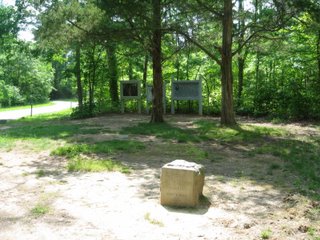 This stone marks a famous location - the site where Lee and Jackson sat on boxes of hardtack and held a firelight conference about how to get at the Federals. It was at the conference that Lee ordered Jackson to swing round and flank the Federals, and it would be the last time they would meet.
This stone marks a famous location - the site where Lee and Jackson sat on boxes of hardtack and held a firelight conference about how to get at the Federals. It was at the conference that Lee ordered Jackson to swing round and flank the Federals, and it would be the last time they would meet.
This monument marks the location where Jackson was shot and wounded. He fell from his horse and was carried to a field hospital some five miles to the rear (to the right of the photo) where his arm was amputated.

The ruin in front is that of Chancellorsville Inn, where Joseph Hooker had his army headquarters. The house was destroyed during the battle. Behind me was a crossroads (now with traffic lights, a signifcant improvement on 1863), through which Lee rode with his cheering troops after the battle.
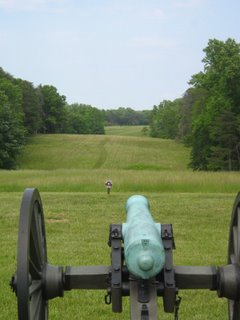
Confederate artillery positions on high ground known as Hazel Grove. After Hooker erroneously ordered it abandoned to try and reconsolidate his lines after Jackson's onslaught, the Rebels lost little time in packing it full of artillery to rain shot and shell down on the Union lines, which were based in the most distant clearing. Chancellorsville Inn is actually about 100 metres to the right of the clearing.
After Chancellorsville, we made our way to the Wilderness. Now, I apologise - I don't have any photos there, primarily because at that point, it started to rain very heavily. Unwilling to risk my beloved Ixus to the elements, we contented ourselves with staying in the car and looking. Essentially the first battle fought between Ulysses S Grant and Lee in 1864, the Wilderness was a brutal struggle in very similar terrain to Chancellorsville, which is unsurprising given that the two locations are but three miles apart. Although the battle ended indecisively, Grant managed to get round Lee's flank and head for a small town called Spotsylvania, to try and cut Lee off from Richmond. Lee managed to interpose his army, and 2 weeks of trench warfare followed. By this stage of war, advances in rifles have brought about an increased use of trenches and emplacements. The battlefields of the later Civil War begin to resemble the trenches of World War One.
Some of the worst fighting of the war occurred at Spotsylvania, as Grant tried numerous attempts to pry Lee out his trenches. The most notable instance was at a location known as the Bloody Angle, where the Federals surprised the Confederate division there, and captured close to 3000 men and 30 cannon. In a last ditch effort to stablise his line, Lee hurled a reserve division into combat, and fighting raged from dawn until midnight over the trenchworks. At the Angle, when the fighting had ceased, over 200 bodies were found in a trench not more than 30 metres long.

The Confederate position was to the left of this earthwork, the Union attacked from the right. The trench extends ahead for some 100 metres, where a monument, visible in the distance marks the site of the angle itself.

This was taken at the Angle, and is mute testimony to the carnage that erupted here.

The bloody Angle. The Confederate trenchline follows the patch of unmowed grass. The trenchline here was called the Angle, because it was where Lee's line bent, before stretching away down to the left. Over one thousand men died in the mowed area behind the Confederate trench.
We bivouaced for the night at a town called Culpeper, where I suffered the aforementioned attack of intoxication. Feeling quite hungover, I was dragged into the car by Dad the next day and driven to Harper's Ferry.
Harper's Ferry was a very successful town prior to the war. It was one of two locations where the US Government established armouries, to produce firearms for the United States Army. Sited on the junction of the Potomac and Shenandoah Rivers, it is surrounded on all sides by high cliffs, which makes for fantastic scenery - but not a good place to defend. It would change hands 8 times during the war - it's indefensible location making it easy pickings for both Union and Confederate forces. With the armament producing machines shipped South by the Confederates early in the war, the bridges into down all destroyed during the war, and a series of devastating floods after the war, Harper's Ferry was all but abandoned by the 20th Century. However, it has been given a new lease on life as a historic town - filled with great museums and exhibits. Both Dad and I were surprised at what was to be found here.

A view from a more modern bridge, of a somewhat older bridge. The bridge I'm standing on is a rail bridge - the bridge in front was also a rail bridge, which the Federals blew up in 1862 before they surrendered the town to the Confederates. The Potomac River is in front of me - the Shenandoah enters from the right.

The main drag in Harper's Ferry. Quite a few old buildings are still in place here, along with plenty of older retaining walls, steps etc.
The most interesting part of the day though, at least for me and Dad was an exhibition by re-enactors of firearms from the various eras of warfare, from the Revolution up to the Civil War. While these guys might seem somewhat comical to some of you, they do take it very seriously, and really know their stuff.

A soldier from the war of 1812. This guy was really good - he talked it up nicely, put on a very good show. The musket he has is a muzzle loading smoothbore, accurate only to about 70 metres.

A small platoon known as the 1st Pennsylvania Volunteers, standing at ease. These guys were equipped with muzzle loading rifles, accurate to about 300 metres.
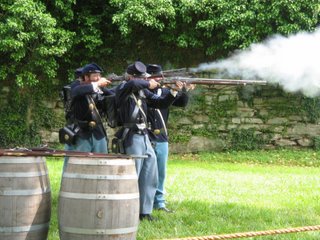
Fire! I've also got some video footage of these guys, which I'll show you at some point I'm sure. (Anyone who knows how to upload videos to blogs, feel free to let me know.)
So, with that, we bid farewell to Harper's Ferry, and this morning made our way to the battlefield at Antietam. Now, Antietam is a spectacular site to visit - it's far from the urban areas that threaten Fredericksburg, Chancellorsville and the like. It's also very easy to picture what happened - the bulk of the fighting occured on open fields, so visibility and a sense of location is easy to achieve. The battle played out in three parts - the first at dawn, in the area known as the Cornfield, the second in the early morning at the Sunken Road, and the last at Burnside's Bridge, in the late morning and early afternoon.

This cornfield doesn't look like much, but it is hallowed ground. By day's end, this field was covered in bodies from both sides. At the time of the battle it was covered in corn, higher than a man. Into this jungle, both Union and Confederate troops charged back and forth, from which many would not emerge. The Union attacked from the far end, directly opposite, and from the right as well. The Confederates counterattacked from where I am standing.


Two angles of the Sunken Road. The Confederates were defending from within the road itself, while Union soldiers attacked from the left in the first photo, and from the right in the second. Bodies were knee deep in the road at the end, as well as in the fields in front of the road. By the end, Confederates were forced to pile their own dead up as cover, before the sheer weight of Union numbers swept them away. The end came when Union soldiers managed to penetrate to where I was standing when I took the second photo, and enfiladed the entire Confederate line, mowing them down where they stood.

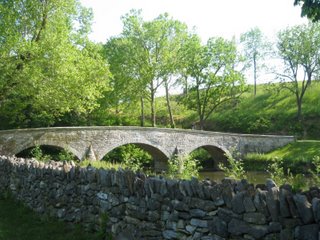
Two shots of Burnside Bridge, so called because of the Union Commander Burnside (the same guy at Fredericksburg.) He managed to completely bungle the attack across the bridge, with his corps of 10000 stalled by about 500 Georgian riflemen on the heights on the far side (the right, in the second photo.) Eventually he managed to get his troops across, but Confederate reserves managed to stop his attack before he could penetrate far into Lee's lines.
It's been a fascinating three days. Tonight we're staying in Hagerstown, in Maryland. Tomorrow I'll be entering Yankee territory for the first time when we cross over into Pennsylvania. With Niagra Falls, Toronto and a fair bit driving to be done, the next few days promise to be just as interesting.
For those of you bored shitless by the military nature of this blog thus far, it's almost at an end. After Gettysburg, the Civil Wargasm that I've been on will draw to a close, and you'll be able to read about more normal pursuits.

8 Comments:
thats some cool arse shit
makes me wish i did some more historic stuff while i was over there
and "battlefield bonanza" reminds me of the surprise spruiker on the chaser
well paul you have your self a following, seems a few at work here find your blog facinating.
Keep up the good work ! :)
man this sounds cool
i wish i had the passion for this kinda stuff as you do, sounds like theres some really cool shit, and well preserved as well..
Nice job.
How funny is that about stoney the stonewall
Friendly fire..
such a american way to die.
The ironic thing about Stonewall Jackson's death was that at the battle of the Wilderness, fought almost exactly a year later, and not more than a couple of miles from Chancellorsville, the same thing happened to the Confederates.
Another of their best commanders, James Longstreet, arguably one of the best tacticians of the war, went down as a result of friendly fire, a bullet piercing his throat and shoulder.
Unlike Jackson he survived, but it was a very near run thing.
yea cos they dont have girls in america or england???
Nah, they have babes and crumpet.
even though i know nothing about the war it is still very interesting paulie. and i have been watching fat pizza on your computer. and there is a paulie on fat pizza. very funny.
Post a Comment
<< Home